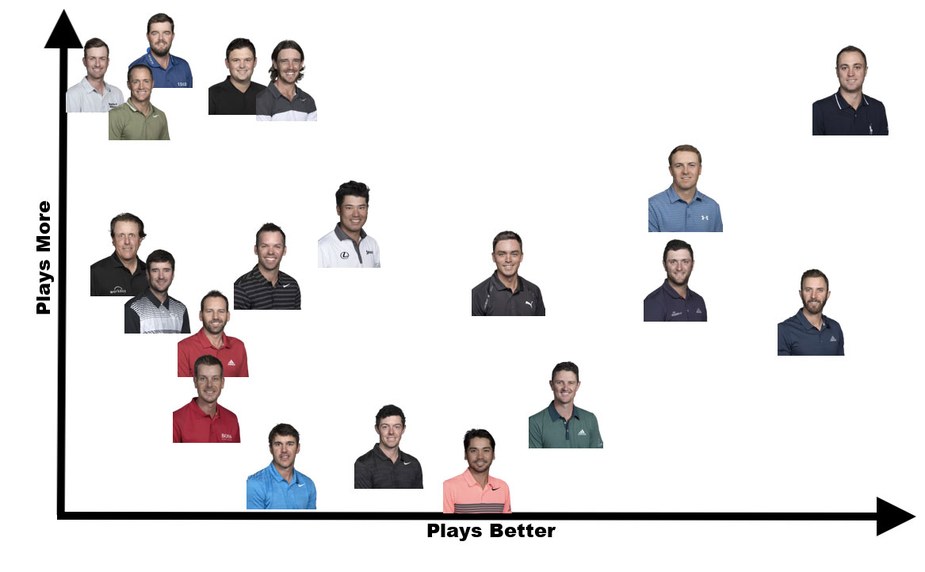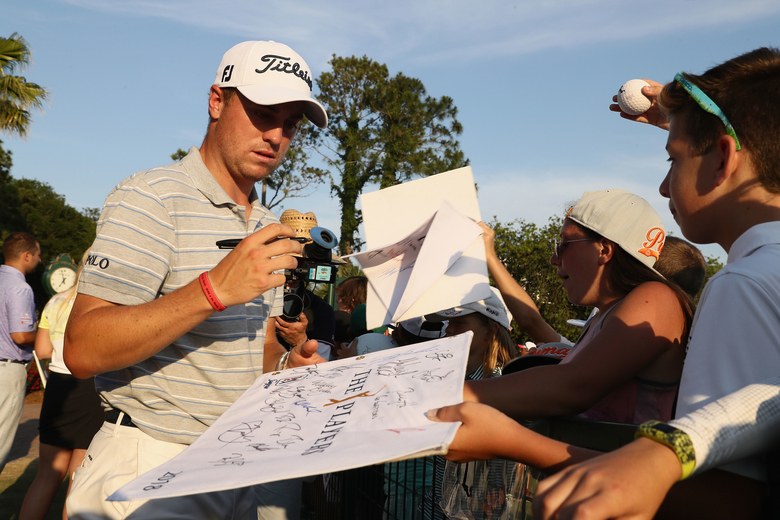Jamie Squire/Getty Images
By Luke Kerr-Dineen
It’s been a busy week atop the Official World Golf Rankings. With his runaway Players Championship win, Webb Simpson cracked the top 20 for the first time since early 2014, but that was minor news compared to what happened at the top. Justin Thomas finally managed to dislodge Dustin Johnson as World No. 1, albeit in a somewhat anti-climatic fashion.
In all, there were 10 changes to the OWGR’s Top 20 after the Players. With such a heavy shake-up, now seems like the perfect time for a quick breakdown of the players residing at the very top of the game.
To be more specific, it’s not really who is in the OWGR Top 20 that’s got My fancy. Rather, how did those players win their points. The chart below is my attempt to answer that question.

[divider] [/divider]
WATCH NOW TIGER WOODS SENDS A “MESSAGE” TO JUSTIN THOMAS
[divider] [/divider]
On one axis is the number of events players play that count towards their OWGR (their divisor). The other is players’ average number of points won during those tournaments.
As you might be able to spot, there are four clusters that quickly emerge.
Cluster 1: Plays Often
The first group—consisting of Webb Simpson, Alex Noren, Marc Leishman, Patrick Reed and Tommy Fleetwood—is nestled in the top left corner of the graph. These players don’t always play incredibly well relative to their top-20 peers, but they play a lot. They win their points either by playing consistently over a high volume at tournaments (think Leishman, who has five top-25 finishes and 11 made cuts in 13 starts this season), or by putting together streaks good enough to negate their inconsistent patches (like Reed, who had four MCs and no top-10s in eight official events before putting together six straight top-10s, including a Masters win).
Cluster 2: Plays Less
Phil Mickelson, Bubba Watson, Sergio Garcia, Henrik Stenson, Paul Casey and Hideki Matsuyama are in the next group. This cluster plays similarly to the first, but they don’t play as often. It’s a dangerous strategy in that you’re the margin for error when they do play is small. Perhaps it’s no surprise, than, that five of these players are ranked between 12th and 20th in the OWGR.
Cluster 3: Plays Less, But Better
This is the real estate where Cluster 2 ideally wants to live. Brooks Koepka, Rory McIlroy, Jason Day and Justin Rose all don’t play as much relative to others in the OWGR’s Top 20, but they rarely disappoint when they do. Day and Rose are the best examples. Together they’ve combined for only 19 PGA Tour starts this season, but have three wins, 15 top-25s between them and neither has missed a cut.
Cluster 4: Plays More, Plays Well
The fourth and final category is the best of both worlds: Players who play often and maintain a consistently elite level. Rickie Fowler, Jordan Spieth, Jon Rahm, Dustin Johnson are all in this group, but as you can see, Justin Thomas is the stand-out. He doesn’t just play often, he also boasts the highest average points won (9.1842) whenever he does play. It’s nothing short of the hallowed ground, and it’s not hard to see why he’s the new World No. 1.









